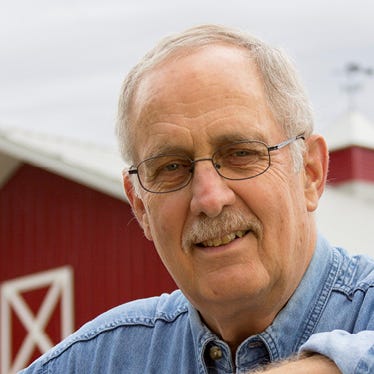January 16, 2017

Denny Dyson of northwest Wabash County has been a Stine Seed dealer for years. He’s come to believe that company founder Harry Stine is a “pretty smart guy.” But four years ago, when Stine tried to get corn growers to plant a new configuration of high-population corn — twin 20-inch rows at a population of 54,000 seeds per acre — Dyson couldn’t help wondering if Harry had shot an air ball.
“I thought there was no way this would work, and for multiple reasons,” says Dyson.
Nevertheless, he thought he’d at least give it a try. The first year, using a planter furnished by Stine Seed, Dyson planted 100 acres in a strip next to 30-inch rows.
First-year observations
Dyson weighed his initial concerns against results. He reached four conclusions.
1. Standability. “I thought there was no way the stalks would stand in that high a population,” he says. “But it stood. Stine had worked on improving stalk strength, and it wasn’t a problem.”
2. Dryness. “I thought, if it gets dry, this crop will be in trouble,” says Dyson. “It did get dry, but it was just the opposite. I have a gun that measures temperature, and the ears were 4 to 5 degrees cooler in the high-population stand. The row configuration and more erect leaves capture more sunlight, so hardly any sunlight gets to the ground, and you have more shade.
"In my 30-inch rows, you could kick up some dust. But the ground in my high-population corn was still dark. I was making better use of the water I had.”
3. Shelling. “I thought shelling would be a problem, but it wasn’t,” Dyson says. “I used a 20-inch corn head and autosteer, and it worked fine. It’s different. You don’t have to stay on the rows. In fact, you can’t stay on the rows. It’s a lot like cutting beans with a bean head.”
4. Residue management. “Yes, there is more residue, but it’s actually been easier to manage than my 30-inch rows,” he says. “It winds up being distributed more evenly. Whether I use an in-line ripper or a tillage tool, it’s really much easier.”
Proof in performance
Although Dyson's initial concerns turned out to be non-issues, the bottom line was the yield. And it didn’t disappoint.
“I got a 50-bushel yield advantage with the twin 20-inch strip, compared to the 30-inch rows, with the same amount of nitrogen,” he says. “That’s when it really got interesting to me.”
Since that first year, Dyson’s planted virtually all of his corn in twin 20-inch rows, with his own Great Plains planter. However, he still strips a small acreage of 30-inch rows in a side-by-side trial just for comparison.
Each year he consistently gets a 30- to 50-bushel yield advantage with the twin 20s. Even with a higher seed bill and lower corn prices, he says he’s still coming out ahead.
Dyson sees higher populations as the “wave of the future,” given that higher yields are going to come not from bigger ears, but from higher populations. But he also admits the practice may not fit everybody’s operation. For starters, you’ll need a different planter and corn head.
“A lot of it depends on where you’re at,” he says. “If you need to replace a planter, you might want to consider it. Also, the advantage is obviously bigger when corn is $7, rather than $3.50. With these prices, you do have to look at the bottom line.”
Boone writes from Wabash.
About the Author(s)
You May Also Like






